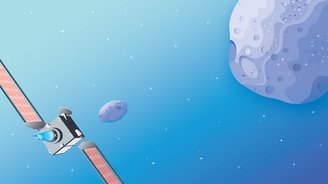Today, March 14, Pi Day is celebrated. The choice of the day is not by chance, as 3/14 is the standard way to write dates with the month in the United States. The numbers correspond to the initial values of the today-honored mathematical constant p(pi), approximately equivalent to 3.14159.
Pi, defined as the ratio of the circumference of a circle to its diameter, is an irrational number and although it is not very popular in Brazil, Pi Day is celebrated around the world. In addition to traditional educational activities, the day also includes competitions to memorize the digits of pi, sharing of pizzas and cakes (starting with the English syllable “pi”), and discussions on the importance of pi and mathematics.
Following tradition, NASA is celebrating Pi Day by launching a series of challenges that anyone can try to solve. The four problems, prepared by the agency’s Jet Propulsion Laboratory Training Department, feature real-life situations that engineers experience to solve important tasks. See below:
Pi Day 2024: The Buyer Puzzle
Inspired by an experiment conducted in December 2023, the mission proposes determining where a demonstration of DSOC (Portuguese for Deep Space Optical Communications) technology installed on the Psyche probe should direct a laser message containing a cat video. thus it reaches Earth and sets a new transmission time record (as in reality).
Pi Day 2024: Cheeky Diversion

The problem here suggests a repeat of the success of the DART spacecraft, which altered the orbit of asteroid Dimorphos in 2022. For this, you need to discover the change in the orbit of the asteroid after NASA’s deliberate impact with the surface with DART (Double Asteroid Redirection Test).
Pi Day 2024: Orbit Observation

In this challenge, you need to measure how much data the NISAR satellite (NASA-ISRO Synthetic Aperture Radar) will capture each time it orbits the Earth, We monitor the soil and icy surfaces of our planet.
Pi Day 2024: Lunar cartographers

To demonstrate CADRE technology (loosely translated as Collaborative Autonomous Distributed Robotic Exploration), you need to calculate the distance a small rover would have to travel to map a portion of the lunar surface.
All of these challenges and supplements are available at the NASA Pi Day Challenge link. You can download the issue sheet, a graphic to place on your desktop, and more information about the topics covered..
Did you like the content? Tell us on our social networks and get the opportunity to share the article with your friends!
Source: Tec Mundo
I’m Blaine Morgan, an experienced journalist and writer with over 8 years of experience in the tech industry. My expertise lies in writing about technology news and trends, covering everything from cutting-edge gadgets to emerging software developments. I’ve written for several leading publications including Gadget Onus where I am an author.













